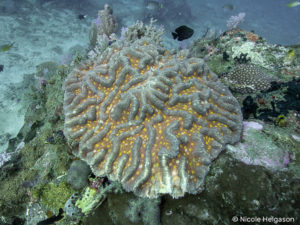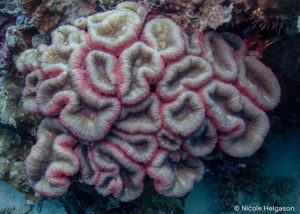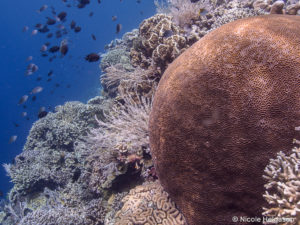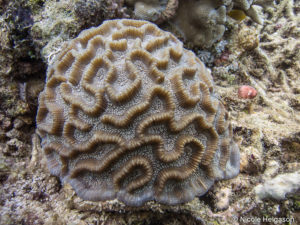Meandering corals are often called brain corals because they form round colonies that resemble brains. There are many different species of brain corals and learning to identify them will help evolve your perception of the underwater world.
If you’re new to coral identification, look at our Coral Biology: Part I and Coral Biology: Part II articles. These will help you learn the basics of coral biology, as well as some helpful terms for identification. And if you’re new to Indo-Pacific Coral Identification make sure to check out our Introduction to Hard Corals of the Indo-Pacific.
Identifying meandering corals
Meandering corals usually grow into round, dome-shaped colonies but sometimes they grow into plates. The skeleton of meandering corals is thick, and they grow slowly, only a few centimeters per year.
When you are looking at a brain coral you can learn two new terms about coral biology: ridges and valleys. These terms describe the shape of the meandering pattern in the coral. These new terms can help with more advanced coral identification. For example, when trying to identify between two similar species you might have to measure the distance between ridges or the size of the valley.
When looking at these corals the polyps are located in the valleys and, depending on the species, sometimes they’re a different color than the rest of the coral.
Here are four meandering brain corals you can identify on your next Indo-Pacific dive.
Symphyllia

Symphyllia is a colorful species that forms a brain shape or a plate shape. This is a very common coral and you’re almost certain to see one on every dive in the Indo-Pacific. It comes in a range of colors and the more — sometimes up to five — you find in one coral, the rarer the colony. Typically, this coral comes in red, yellow, and gray. Often the polyp mouths, which are located in the center of the valley, are a different color than the coral tissue.
Lobophyllia

Lobophyllia corals form thick tissue and large lobes. Each lobe can have a few polyp mouths, depending on size, and has one stalk that connects at the base of the coral. At night the lobes open and you can see all the tentacles coming out to feed.
This is a slow-growing coral that can create huge colonies in the shallowest parts of the reef. The lobes can be more than 6 inches (15 cm) wide.
Platygyra

Platygyra is a common meandering coral that has short, compact ridges. Depending on the species, the ridges and valleys can be long and continuous or intersect to form little sections. The valleys are close together, often less than 1 cm wide. If you look between the ridges, you can see the polyp mouths in the center of the valley.
Oulophyllia

Oulophyllia is an uncommon coral with only a handful of species in the genus. The color is usually a gray to light green with distinct oral discs. The colonies are small and make little domes.

